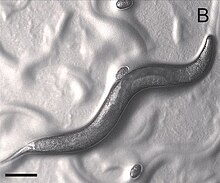Pristionchus
| Pristionchus | |
|---|---|
 |
|
| Pristionchus pacificus | |
| Scientific classification | |
| Kingdom: | Animalia |
| Phylum: | Nematoda |
| Class: | Chromadorea |
| Order: | Rhabditida |
| Family: | Diplogastridae |
| Genus: |
Pristionchus Kreis 1932 |
Pristionchus is a genus of nematodes (roundworms) that currently includes 48 described species. They are known mainly as non-parasitic associates of insects, especially beetles, while others have been reported from soil, organic matter, or rotting wood. The genus includes P. pacificus, a satellite model organism to the well-studied nematode Caenorhabditis elegans.
In Pristionchus species associated with insects, the nematodes usually live on their hosts in a dormant stage (the dauer larva). After the death of the host insect, the nematodes resume development, feeding and reproducing on the decaying host carcass. Most species of Pristionchus show a polyphenism in their feeding structures, which allows the nematodes to access different food resources in this rapidly changing environment. In one form (the "stenostomatous" form), the mouth is elongated, narrow, and equipped with one small tooth, whereas in the other ("eurystomatous" form) it is short, wide, and with two large teeth. The emergence of a particular form depends on specific environmental conditions and the availability of food. Whereas the stenostomatous form feeds primarily on microorganisms, the eurystomatous form can feed additionally on other nematodes. In the laboratory, Pristionchus species can be cultured on bacteria such as Escherichia coli.
Most known species of Pristionchus have males and females, although several species are androdioecious, consisting of males and self-fertilizing hermaphrodites. Sex determination in Pristionchus species is by an X0 system, whereby males have one sex (X) chromosome and females/hermaphrodites have two.
The following is a selection of Pristionchus species:
...
Wikipedia
